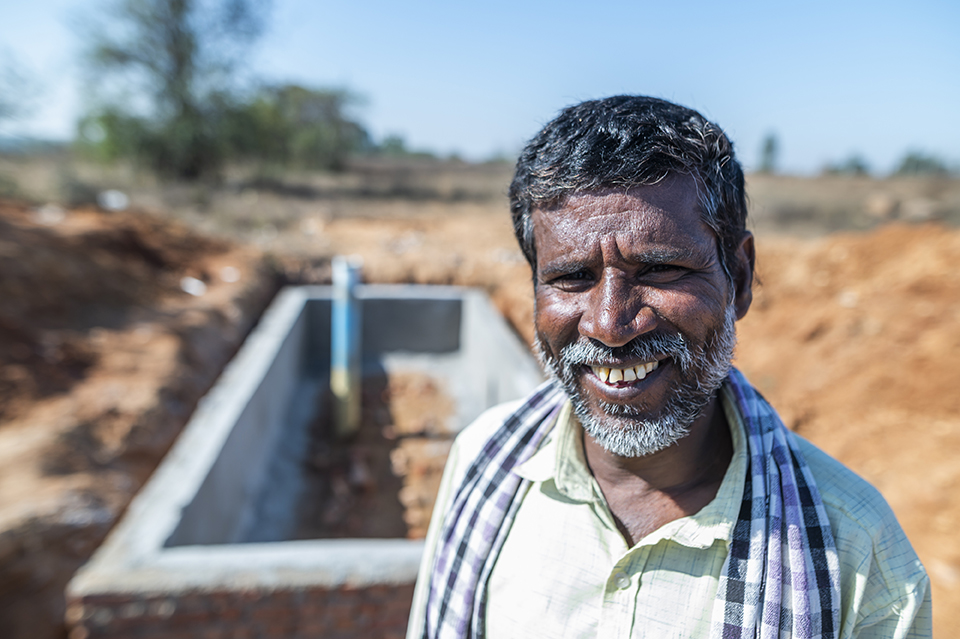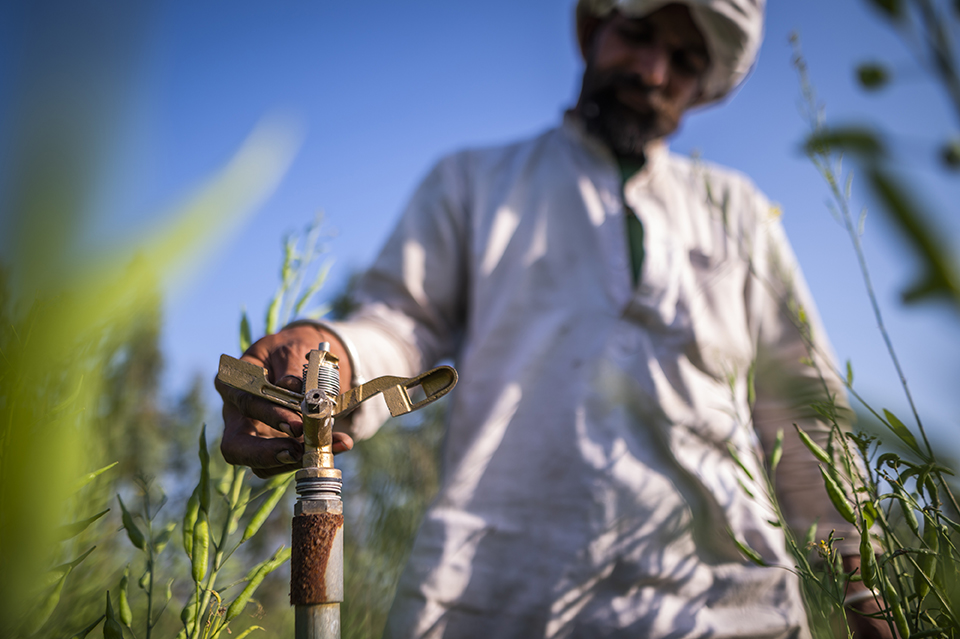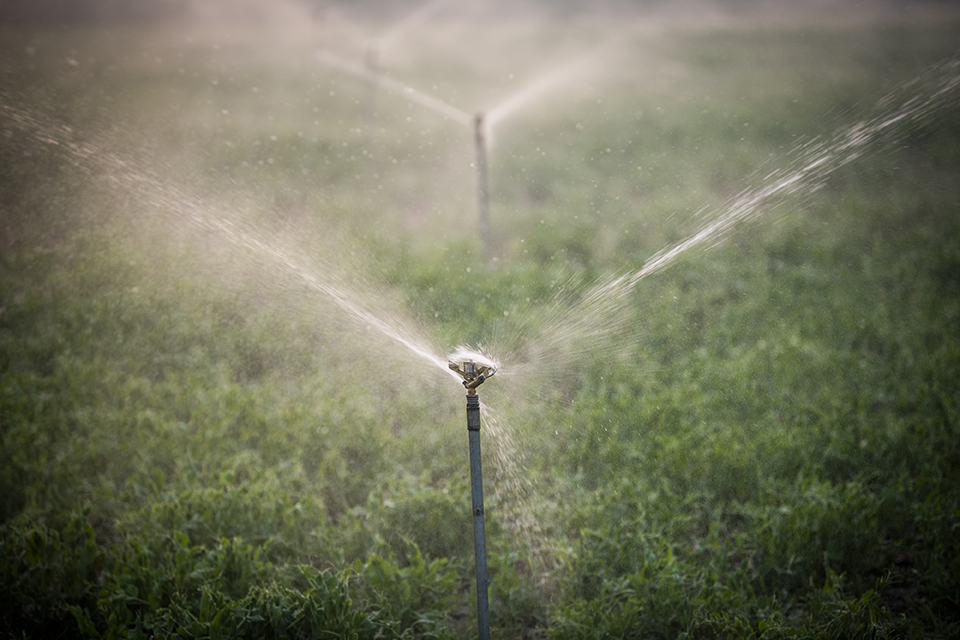22nd March 2023
To mark World Water Day 2023, we invited WaterAid India to tell us about the water challenges faced by farmers in India and the practices they are implementing together to promote water stewardship.

45 years old Lal Singh, a farmer, stands infront of an underconstructed borewell near his house at Bomma Reddy Gudem, Sangareddy, Telangana, India, February 2023. WaterAid/India/Sudarshan
Guest blog
While access to improved water sources in India has significantly increased (from 68% in 1992-93 to 89.9% in 2015-16), the country faces its worst water shortage in history.
Approximately 600 million people are affected by high to extreme water shortages, according to a report by Niti Aayog. About three quarters of rural households in the country don’t have access to drinking water on the premises. Erratic rainfall and recurrent drought in the country has resulted in acute water scarcity for domestic and livelihood needs.
Water extractive technologies have caused a decline in the active use of traditional knowledge, local systems of water resource management and decentralised water governance. All of these have increased water security risks and losses.
There are, however, positive trends. For instance, the central government has launched three flagship programmes:
- Jal Jeevan Mission, aiming to provide safe and adequate drinking water through individual household tap connections by 2024 to all households in rural India.
- Jal Shakti Abhiyan, an annual campaign focusing on saving and conserving rainwater.
- Atal Bhujal Yojana, to demonstrate community-led sustainable ground water management which can be scaled up.
It is very encouraging to see the funds deployed in these programmes and the fervour with which these are being implemented. The Government has also initiated measures to promote wastewater recycling, a significant step, as improved piped water access in the villages is likely to generate more wastewater. If left unaddressed, this is likely to further contaminate the surface water sources in the rural areas.
Such an environment is a great opportunity to initiate water stewardship. Under this initiative, we learn from traditional expertise, augment with modern science and tools to enable people and local institutions to take informed actions. A collective action that will enhance resilience and adaptive capacities.
A farmer’s connection to the rains can be defined through a kaleidoscope of emotions—from deeply poetic to harshly real. It is the rains that they look forward to nurture their crops and for a good harvest. In India, rain-fed agriculture accounts for about 51% of the net sown area and for nearly 40% of the total food production.

50 years old Dharmendra, a farmer, works in his farm at Mukimpur village in Murthal, Sonipat, Haryana, India, February 2023. WaterAid/India/Srishti Bhardwaj
What happens then, when the rain that farmers are so heavily dependent on becomes erratic? Climate change and its ramifications—long spells of drought, sudden onslaught of rain leading to floods—are among the biggest challenges facing agriculture today. For farmers who grow water-intensive crops such as sugarcane, this has proved to be particularly devastating. This highlights the urgent need for water stewardship in the production of commodities like sugarcane.
In 2021-22, India became the world’s largest producer and consumer of sugar, as well as its second largest exporter. Undoubtedly a critical crop for the Indian economy, sugarcane accounts for about 10% of the agricultural output and is the main source of livelihood for about 50 million farmers and their families.
Over the past few years, however, erratic rainfall and long spells of drought have wreaked havoc for sugarcane farmers.
Maharashtra and Uttar Pradesh are the two major sugarcane producing states in the country. But with such instability in weather conditions, agricultural harvest suffers. It could be a bumper crop one year, a poor harvest the next. For the water-guzzling crop that sugarcane is, this is an either-or situation. According to the Niti Ayog report, on average, one kilogram of sugar requires 1,500 to 2,000 litres of water. ‘Pressure on water due to sugarcane cultivation in states like Maharashtra has become a serious concern, calling for more efficient and sustainable water use,’ the report said. Alternative cropping patterns can be an alternative, especially in regions where groundwater use has reached a critical or overexploited stage, or where 50% surface water is used for sugarcane alone.

42 years old Naresh Kumar, a farmer, installs a sprinkler at his farm at Mukimpur village in Murthal, Sonipat, Haryana, India, February 2023. WaterAid/India/Srishti Bhardwaj
At WaterAid India, we engage with communities and farmers who grow sugarcane, rice wheat, potato, pulses, and vegetables and promote water use efficiency in Agriculture. While working in rural settings, our aim has always been to mobilise communities through Jal Chaupals. This initiative aims to promote the concept of water budgeting, initiate discussions on the demand and supply of water, which happens to be a great conversation starter in these communities and navigate them to the cause of replenishments.
These water budgeting exercises help the communities to develop and implement their water security plans. To ensure that the plan is met out in letter and spirit, technologies around aquifer mapping and ground water recharge are paving their way to simple solutions like rainwater harvesting in institutions for decentralised storage, use and recharge.
The recycling and reuse of ‘grey water’ has also been one of the core areas of our work. That has led to the development of waste stabilisation ponds in the communities. These are large pools where wastewater settles and decomposes, thanks to naturally occuring bacteria that are present. Construction of soak pits – covered, porous-walled chambers that allow water to soak slowly into the ground – and abandoned dug well recharges have also been promoted in the communities.
Alternatively, apart from our regular WASH project – which helps to improve water, sanitation and hygience practices – we are promoting sustainable irrigation methods that require less water and prevent wastage. For instance, drip irrigation methods and usage of sprinklers in fields to grow crops haven’t only saved water, but have also helped farmers plan their irrigation cycles better, leading to better crop yields.

Sprinklers running in 40 years old Sajjan Singh’s farm at Nangal Khurd village in Murthal, Sonipat, Haryana, India, February 2023. WaterAid/India/Srishti Bhardwaj
We encourage farmers to revive traditional water bodies and abandoned bore wells and motivate them to use dug well recharge to replenish groundwater. Our waste stabilisation ponds, which are created in villages mainly to manage liquid waste, are helpful as the water is naturally treated and can be used for agricultural practices.
These collective efforts towards water usage – that are environmentally sustainable, economically beneficial and socially equitable – don’t just serve sugarcane farmers but all other farmers as well.
Climate change, after all, doesn’t discriminate, nor should our efforts to help mitigate its impact.

WaterAid India
——————
Water stewardship is a necessary component of a more sustainable sugarcane sector. At Bonsucro, we’re working with our members to improve the environmental impact of sugarcane production and champion water use.
The Bonsucro Production Standard v5.2 includes an indicator on water use; indicator 4.3.3, “promoting sustainable water use by engaging in collective actions”.
By documenting their engagement in collaborative and collective action, Bonsucro members can make progress towards ensuring sustainable water use. When water resources are stressed or scarce, community engagement becomes vital – catchment water planning and management, encouraged by the Production Standard, can be key tools to help allocate water equitably and without conflict.
Bonsucro certification has proven effective; research showed a 41% reduction in water use in certified mills after five years of certification.
A study led by the University of Minnesota in 2019 revealed that the widespread adoption of Bonsucro’s Standard could reduce water use in the sugarcane sector by 65%.
We stand ready to support more sugarcane producers and buyers with their sustainable farming and sourcing journey. Learn more about Bonsucro certification and get in touch with our team at info@bonsucro.com.




